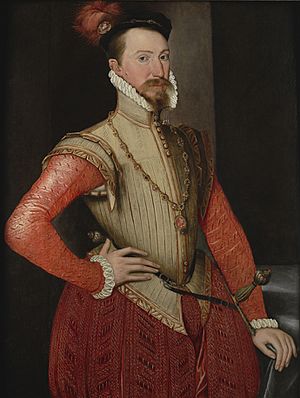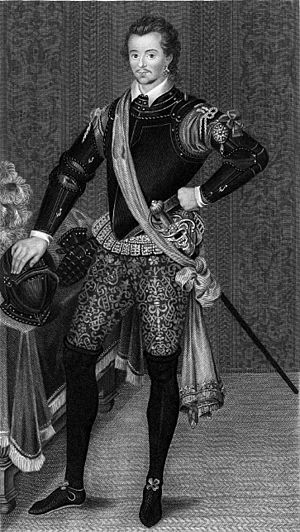Douglas Sheffield, Baroness Sheffield facts for kids
Quick facts for kids
Douglas Sheffield
|
|
|---|---|
| Lady Sheffield | |
| Born | 1542/1543 |
| Died | 1608 Westminster |
| Noble family | Howard |
| Spouse(s) | John Sheffield, 2nd Baron Sheffield Sir Edward Stafford |
| Issue | Elizabeth Butler, Countess of Ormonde Edmund Sheffield, 1st Earl of Mulgrave Sir Robert Dudley (illegitimate) |
| Father | William Howard, 1st Baron Howard of Effingham |
| Mother | Margaret Gamage |
Douglas, Lady Sheffield (née Howard; 1542/1543 – 1608), was an important English noblewoman. She was known for her close relationship with Robert Dudley, 1st Earl of Leicester, a favorite of Queen Elizabeth I. She was also the mother of explorer and cartographer Sir Robert Dudley.
Many years after Leicester's death, Lady Sheffield claimed in a court case that she had secretly married him. However, she had married someone else while Leicester was still alive.
Early Life and First Marriage
Douglas Howard was the oldest daughter of William Howard, 1st Baron Howard of Effingham. Her mother was Margaret Gamage. Douglas was likely named after her godmother, Margaret Douglas, Countess of Lennox. One of her brothers was Charles Howard, 2nd Baron Howard of Effingham, who became a famous Lord Admiral.
Douglas Howard probably started working at the royal court around 1559. She may have been a maid of honour, helping the Queen. In 1560, she married John Sheffield, 2nd Baron Sheffield, a wealthy nobleman. They had two children:
- Edmund Sheffield, 1st Earl of Mulgrave, born in 1565.
- Elizabeth Sheffield, who later married Thomas Butler, 10th Earl of Ormonde. Elizabeth died in November 1600.
Relationship with Robert Dudley

After her first husband, John, Lord Sheffield, died in December 1568, Douglas began a close relationship with Robert Dudley, 1st Earl of Leicester. He was a very important person at Queen Elizabeth's court.
At one point, Leicester wrote her a letter. He explained why he could not marry her, even to have a child who could inherit his titles. He said it would cause his "utter overthrow" and he would lose the Queen's favor. He suggested she consider marrying someone else for her own reputation. He promised to help her if she chose to marry another person.
In May 1573, a court writer named Gilbert Talbot noticed something interesting. He wrote that Lady Douglas and her sister, Frances Howard, were both very fond of the Earl of Leicester. He noted that they were "at great wars together" because they were competing for his attention. The Queen was not pleased with this situation.
In August 1574, Douglas gave birth to her son, Robert Dudley. Leicester accepted that he was the father of this child, who was born outside of marriage. He cared deeply for young Robert and made sure he received a good education.
It's not clear how long Douglas's relationship with Leicester continued. Nearly 30 years later, she claimed that Leicester wanted to end their relationship around 1578. This was before he married Lettice Knollys. She said they met in a garden at Greenwich. She claimed Leicester offered her money to deny they had ever been married. She said she refused at first but later accepted the offer.
In 1604, Lady Sheffield also claimed she refused to give up her son, Robert, to Leicester. She said she feared Leicester would harm him. However, there is no other evidence of any disagreement about Robert's upbringing. He grew up in the homes of Leicester and his friends. He was allowed to visit his mother whenever she wished.
Second Marriage and Court Case

On November 29, 1579, Douglas Sheffield married Sir Edward Stafford. His mother, Dorothy Stafford, was very influential with the Queen. From 1583 to 1591, Edward Stafford served as the English ambassador to France. Douglas went with him to Paris. There, she became a well-known figure in French society. She even became a special friend of Catherine de' Medici, the Queen Mother of France. Douglas advised her on how to improve the French royal household.
Douglas and Sir Edward Stafford had two sons, but both died when they were young. Sir Edward respected his wife greatly. However, he had to deal with her strong feelings about the Earl of Leicester. Sir Edward was politically against Leicester, and these personal feelings made their rivalry worse.
After Queen Elizabeth died in May 1603, Lady Sheffield's son, Sir Robert Dudley, began to try and claim his father's titles. He wanted to be recognized as the Earl of Leicester and the Earl of Warwick. He said a man named Thomas Drury told him that his parents had been secretly married.
This case went to a special court called the Star Chamber between 1604 and 1605. It attracted a lot of public attention. The court heard from many witnesses. Lady Sheffield did not attend the trial in person. However, she stated in writing that Leicester had promised to marry her in 1571. She claimed they were married in Esher, Surrey, in the winter of 1573. But all ten people she named as witnesses were already dead. She also could not remember the clergyman's name or the exact date of the marriage.
As an explanation for marrying Edward Stafford, she claimed Leicester had tried to poison her. She said that because "life being sweet," she decided to marry Stafford "for safeguard of her life." The Star Chamber court did not accept her evidence. They concluded that Sir Robert Dudley had been tricked by Thomas Drury, who was seeking "his own private gains."
Sir Edward Stafford died while the court case was happening. When asked questions for the case, he said that Sir Robert Dudley had "terrified" his mother into supporting him. Stafford wrote that he asked his wife in December 1579 if she had been promised to Leicester. She replied with "great vows, grief and passion" that she had trusted Leicester too much and had nothing to prove he was supposed to marry her.
Douglas Sheffield died in early December 1608 in Westminster. In her will, she left a black velvet bed and other items to her "honourable and beloved son Sir Robert Dudley."
|

